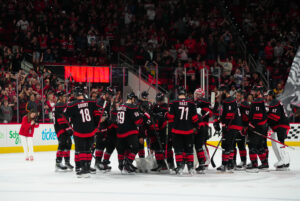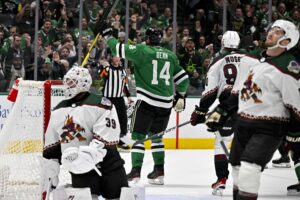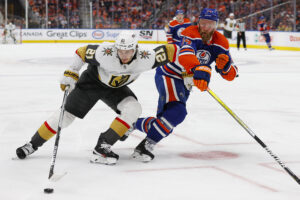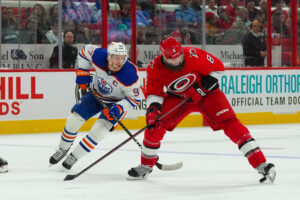In late June of 2019, the Nashville Predators dropped the jaws of many fans around the league. After trade rumours swirling for months, they finally traded away star defenceman P.K. Subban to the New Jersey Devils. In return, they received what was seen by many as a laughable package: containing Steven Santini and two second-round draft picks.
Nearly a year later, it seems the Predators may have been ahead of the curve. After a disappointing 2018-19 season, Subban continued his fall from grace with New Jersey. In only a three year span, Subban has pulled a complete 180. He has gone from one of the best defencemen in the league to one of the worst.
P.K. Subban has Crashed
The 180
2017-18
The 2017-18 season was business as usual for Subban. It was his fourth-straight season of a double-digit goals-above-replacement (GAR) tally, his sixth in his career. His 11.4 GAR was tied for 14th in the league, ranking him ahead of other elite players like Victor Hedman and Alex Pietrangelo. It was another terrific performance from Subban, who scored 59 points in 82 games, seventh among defencemen.
This performance was simply par-for-the-course – his fourth career season of over-50 points through only eight career years. While it certainly wasn’t the season to ink Subban as elite, it served to emphasize his great ability. He was solidified as a truly top-end talent, bringing great scoring ability, strong defence, and admirable size to the table. Then, he fell off the edge.
2018-19
The 2018-19 season was completely unheard of for Subban. He still scored an admirable 31 points in 63 games but the advanced stats all pointed towards a very scary backdrop. In terms of GAR, Subban was nearly perfectly replacement-level, albeit slightly below, with a -0.6 GAR. This was in the company of players like Xavier Ouellet, Cody Ceci, and Christian Djoos; far from the elite company he was among only a year prior.
Joining Subban’s replacement level GAR is an almost-perfectly replacement level wins-above-replacement (WAR) and shots-per-above-replacement (SPAR) – 0.1 and 0.2 respectfully – as well. His on-ice performance and shooting was also balanced out, with a slightly-above-average 2.68 xGF/60 and a slightly-below-average 2.55 xGA/60.
It was all-in-all a very… replacement level season. Subban’s GAR, WAR, SPAR, xGF/60, xGA/60, CF/60, CA/60… they all balanced Subban out to the perfect-neutral. Thanks to an injury that held him out of six weeks of play, Subban was held to replacement level. It was a tremendous dive off of a cliff, a terrific fall from league-elite to nearly-perfectly replacement level.
2019-20
But Subban wasn’t done with his stark decline… not even close. After a 2018-19 season that would put any Chicago Blackhawks veteran to shame – looking at you Duncan Keith – Subban went on to etch his mark as one of the worst in the league this season.
Following the GAR logic established, Subban effectively ranked 298th in the league… out of 298 defensemen. His WAR and SPAR were also the worst among the league’s defensemen. Looking outside of these above-replacement stats, his xGF/60 ranked 94th among the 141 defencemen to play at least 800 minutes this season. His xGA/60 ranked 125th. His CF/60 was in the bottom-45, his CA/60 was in the bottom-15, and xGF%/60 was the fifth-worst in the league.
This is a heavy load of stats but every single advanced stat point towards Subban being one of the worst defencemen in the league this year; the worst when using GAR, WAR, and SPAR which are common determinants in the advanced stat-community.
Only two seasons removed from truly elite company, Subban fell to the company of players like Johnny Boychuk, Mike Green, and Jack Johnson; three of the league’s biggest has-beens. It was one of the biggest – and considering Subban’s fan-favourite personality: most upsetting – falls from grace that the NHL has ever seen.
The Visual
While it’s easy to list off numbers, Subban’s career GAR/WAR chart perfectly puts the decline into picture:

Both graphs show Subban’s immediate explosion onto the scene. He became an elite defenceman almost immediately after joining the league and stayed that way for years. It’s a stretch to be incredibly proud of, followed by a dive steeper than The Palisades. By the numbers and the chart, Subban completed an uncanny 180, tallying a 11.4 GAR in 2017-18 and a 10.1 GAR in 2019-20.
What Happened?
Injuries
Answering what happened is an uphill battle. While injuries are the easy answer, such a jump down can’t entirely be blamed on injuries. With that said, injuries are definitely a factor; and the most famous factor in many’s eyes.
In mid-November, 2018, Subban was placed on injured reserve with an upper-body injury. Prior to the injury, Subban netted 12 points in 18 games. It was on pace with everything he had set up in the prior seven seasons: he was an all-star playing as well as anyone could have expected.
Even though he only missed just over a month with the injury, it clearly changed Subban. He came back from injury and finished the season with only 19 points in his final 45 games. It gave him a grand total of 31 points on the year, a career-low.
The fall-off didn’t stop with the 2018-19 season, though. After a terrible four months following the injury and a full summer to recover, Subban had the worst season he’ll likely ever have this year. It was a horrendous, bottom-of-the-barrel level year and one that, truly, couldn’t be chalked up to simply a short-term injury. There had to be something else nagging Subban.
The Power-Play
Subban’s ability was, really, thin-veiled. While he was a terrific talent, 43 percent of his points between 2012 and 2018 came on the power-play. This includes 24 of his 38 points in the 2012-13 season and 41 percent of his goals in the same six-year stretch. While not highly-dramatic, Subban’s high-end offence was clearly based on the power-play. When at even strength, Subban’s xGF/60 during his six-year reign ranged anywhere from 2.37 (2014-15) to 2.53 (2015-16), not too far off from the general league-average of 2.4.
Ultimately, Subban’s high-end scoring lines up perfectly with his power-play ice time. He tallied over 300 minutes of power-play time in each of the three seasons between 2013 and 2016, often eyed as the best of his career. This includes the 2015-16 season, when Subban recorded the second-highest power-play time of his career despite playing in only 68 games – and scoring at a career-high-pace with 51 points.
The Power-Play Decline
Throughout his entire career, Subban had never played in under 170 minutes of power-play time until the 2018-19 season, conveniently linked to the start of his decline. The 2018-19 season also marked the fewest shots that Subban had taken on the power-play (31) in his career; only the second time in his then 10 year career that he had recorded fewer than 55 shots on the power-play. That is until the 2019-20 season when he topped his career-low with only 28 shots on the power-play.
The dramatic drop off in both special teams ice time and shooting, Subban’s coinciding downward spiral is no surprise at all. His high power-play scoring and advanced stats point a clear line to his reliance on the man-advantage. When that floor fell out from under him in his last year in Nashville and in New Jersey, Subban fell with it.
The Fix
With such an utter reliance on the power-play, a fix seems a bit intuitive: give him more time on the power-play. If Subban can get back to the high-ice time and high-shooting that he was once so comfortable with, assuming his high-points to return wouldn’t be unreasonable. Unfortunately for him, though, that’s not as easy as it may seem.
Subban’s ample power-play ice time in the prime of his career came from a complete devotion from his coaches. Between 2013 and 2016, Subban appeared in over 75 percent of the Montreal Canadiens power-play, by time. He also accounted for 25 percent of Montreal’s power-play shots. Between 2016 and 2018, he also appeared in nearly 50 percent of the Predators man-advantage, accounting for 14 percent of their shooting.
But his move to New Jersey also brought a move to one of the league’s most notably ineffective power-plays. They’ve ranked in the league’s bottom-10 in power-play percentage in each of the last two seasons. Subban only appeared in 42 percent of this unsuccessful power-play and contributed a bleak nine percent of their shots. He went from being the focal point of the Canadiens and Predators power-play to a forgettable addition of New Jersey’s.
The System
This wasn’t Subban’s fault, though. Oddly enough, New Jersey’s power-play doesn’t seem to involve defensemen at all. Despite similar ice time totals to Subban, both Will Butcher and Damon Severson were also held to only nine percent of the Devils shot totals.
The ineffectiveness of the defencemen is entirely an issue of the Devils power-play system. While they try to imitate the 1-3-1 “bumper” power-play style that’s become the league’s common system, they do it with a very “New Jersey Devils” sense of flare. That is through mucking up the system as their 2019-20 season fell increasingly to the wayside. As they slipped further into the depths of the league, the defenceman manning the point on New Jersey’s power-play became increasingly obsolete. Instead, their play ran almost entirely through the players on the wings, who even carry the puck along the blue-line when play shifts up.
Fixing the System
Simply put, the woes of the unsuccessful Devils power-play didn’t give any opportunities to their defencemen. Fixing Subban’s fall from grace isn’t as simple as giving him the puck more on the power-play. Instead, the Devils need to completely rework their man-advantage. Given the team’s complete lack of success on the power-play, and in general, it’s clear the typical winger manning the power-play isn’t working. Instead, they need to learn to work the man-advantage through their defenceman at the top: a rarer but very promising system.
For teams like the St. Louis Blues, who have power-play dynamos like Alex Pietrangelo, having a defenceman to quarterback the power-play works wonders. It allows the team to work from side-to-side much easier while also allowing the defenceman to flex the talent that earned him the power-play role to begin with. With a power-play specialist like Subban, adding this layer of trust could lead to great success. Simply put, instead of ignoring him entirely on the power play, the Devils need to build their system around Subban, who has more than earned respect on the man-advantage.
There’s Still Questions
While Subban’s fall from grace lines up perfectly with a downward-spiral in his power-play presence, it seems off to say that fixing the special team unit in New Jersey will fix the defencemen entirely. With the injury surely playing a hand in Subban’s fall, there could easily be underlying issues plaguing Subban’s play. Many also think that issues with the Devils coaching and new teammates or Subban’s off-ice, social media presence could be contributing to his fall.
The fixes to these other fixes aren’t as black-and-white, though. If the one-month injury is still bugging Subban years later, he needs to take the time to fully heal instead of trying to push through it. For Subban, the long break the Devils face due to the COVID-19 pandemic may give him the time to heal any lingering back issues. However, any potential issues with coaches or teammates are more ambiguous fixes.
The only black-and-white fix is to the team’s power-play. Not only is the Devils power-play struggling to begin with but a newly-found power-play presence has the potential to easily restore some of Subban’s former glory.
Main Photo:






